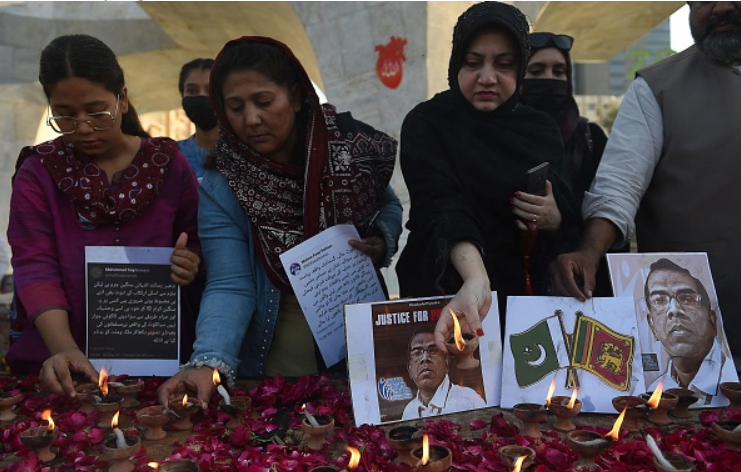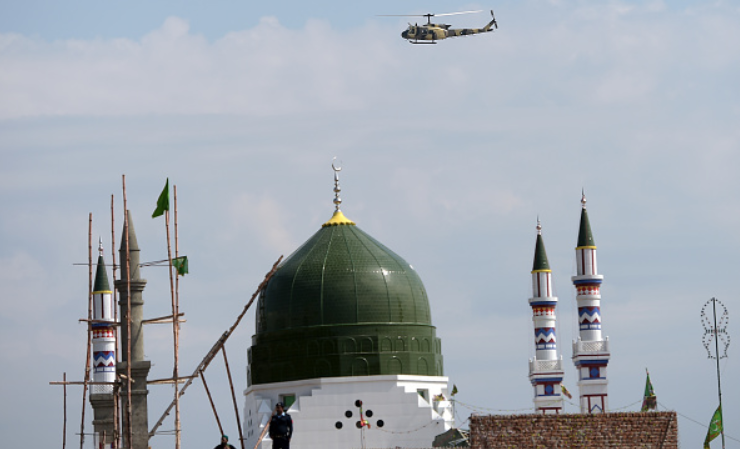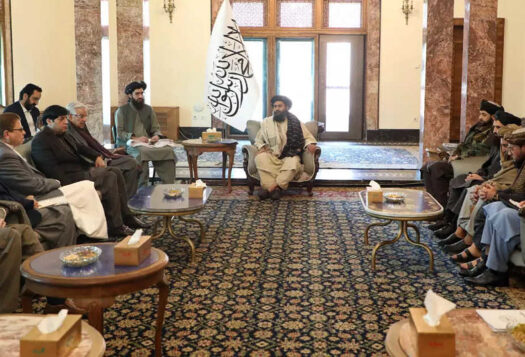
The mob-lynching of a Sri Lankan national, 49-year-old Priyantha Kumara, in Pakistan’s eastern city of Sialkot challenges Pakistan’s government and, more broadly, the state. The ghastly lynching and desecration of the body caused a diplomatic crisis between Pakistan and Sri Lanka, two countries that, traditionally, have had cordial relations. Prime Minister Imran Khan immediately spoke to the Sri Lankan President Gotabaya Rajapaksa to “convey our nation’s anger [and] shame,” and offer assurances that perpetrators would be prosecuted under the law.
Beyond the diplomatic tensions however, the brutal killing has brought to the forefront the challenge of how to deal with violent acts of ideologically charged mobs when the state’s constitutional-legal compact itself is infused with laws that create the space for such violence. Blasphemy laws are a prime example of that. The laws were inherited from British colonial rule, which were codified in 1860 and expanded in 1927. Pakistan inherited these laws, but they lay buried in the penal code until they were resurrected and provided teeth in the 1980s during the military dictatorship of General Zia ul Haq. Between 1980 and 1986, a number of clauses were added to these laws and the punishment was enhanced from jail sentences to recommended death penalty and life imprisonment.
The brutal killing has brought to the forefront the challenge of how to deal with violent acts of ideologically charged mobs when the state’s constitutional-legal compact itself is infused with laws that create the space for such violence.
It is a matter of record that not a single blasphemy case (an omnibus term for a number of provisions in the laws) has stood the trial at the Supreme Court of Pakistan even as the High Courts—the highest appellate courts in the provinces and the Capital Territory of Islamabad—in some cases have upheld decisions by the District and Sessions (D&S) Courts that have a nearly 100 percent record of finding the accused guilty, especially in cases that become high profile. Human rights and legal bodies maintain that D&S Courts unload the burden to appellate courts because of the presence—always—of large, charged mobs inside and outside the courts on the day of court judgement.
Even if acquitted, those charged with blasphemy face the threat of mob violence or death. While the laws are unique to Pakistan, the ethos of the violence is familiar. Such acts of “democratic violence,” where the majority asserts dominance over the minority under the shadow of tacit protection by the state have echoed throughout history and into the present. Thus, it is not an isolated incident of horrific violence that Pakistan finds itself facing, but the system that allows such social violence to exist and continue.
A Swift Response
Police in Pakistan’s largest province of Punjab—normally accused of slackness and inefficiency—acted swiftly and professionally. Among their tasks were items police in other countries would be unlikely to have on their checklist. Along with clearing the highway and the mob, the District Police Office (DPO) also had to ensure that other religious groups, especially Tehreek-e-Labbaik, did not back the perpetrators. As the Senior Superintendent of Police, Omar Saeed, explained to me during the visit to Sialkot the DPO had reached out to religious groups and civic and lawyers bodies pressing them to issue statements condemning the act. Finally, the police needed to try and ensure that no footage of the arrested men emerged that showed them performing acts of religion piety and draw support for them.
Listing these functions is important for putting such instances in perspective—as failure to act quickly can rapidly change the environment on the ground. In previous cases, crowds have come out to show their support of the perpetrators. Mumtaz Qadri, a police constable who murdered Punjab governor Salman Taseer over his opposition to blasphemy laws, was presented with garlands from crowds of supporters, including lawyers. Later, video clips appeared showing him reciting the Quran and praying in jail. His Barelvi supporters created a saintly aura around his person, which was done deliberately to garner more support for him and pressure the prosecution. Prison guards were shown treating him with great deference. In at least one case, he managed to convince a prison guard to kill a man accused of blasphemy in the accused’s cell.
“Democratic Violence”
While the police and politicians have been quick to respond to and condemn the violence, it is critical to question the causes that made way for the violence to begin with. As Ilhan Niaz, professor of history at Pakistan’s Quaid-e-Azam University said to me: “The important thing about racial lynching and blasphemy is that they are forms of democratic violence and designed to assert majority dominance over the victims. Although the act of lynching itself is illegal, it has wide social acceptability and is framed in terms of vigilante justice [Prime Minister Khan used the term to describe the Sialkot lynching]. Privileged individuals, leaders, clergy [and others] engage in formal condemnation of the violence while refusing to address the underlying cause of it.”
Professor Niaz’ observations are spot-on. The basic methodology of mob violence is the same. Someone commits a real or imagined social transgression—like Aasia Bibi drinking water, or Kumara allegedly tearing off a sticker—and they are mobbed or forced to flee the country. To those who remain the message is clear: if you transgress an imaginary and arbitrarily defined boundary you will be mobbed, exiled, beaten, or otherwise subjected to unbearable social and legal sanctions. Niaz calls it “a form of social terrorism.”

The perspective is also important because every time such an atrocity happens, and it has happened before, the progressive-liberal sections demand that the state and its enforcement agencies act and eradicate this menace. The question is: how does one do that when the problem is not merely an issue of law and order but of a sickness that has crept into large sections of society?
The violence and lynching that were pervasive across the Southern United States along with discriminatory Jim Crow laws offers an analogy as well as a case study in how the Southern states of the United States entrenched discrimination against African Americans into the law for more than a century after the Civil War. Many of those biases and their institutional expression persist to this day and echoed through the Black Lives Matter movement.
A 2015 Equal Justice Initiative (EJI) report titled “Lynching in America: Confronting the Legacy of Racial Terror,” documents 4,084 terror-lynching of African Americans in twelve states between 1877 and 1950. The report further distinguishes between “terror lynchings” and other forms of racial violence or hate acts, noting: “The lynchings we document were acts of terrorism because they were carried out with impunity, sometimes in broad daylight…they generally took place in communities where there was a functioning court system that was deemed too good for African Americans.”
The challenge is to develop strategies that tackle the immediate through enforcement as well as address what British playwright Edward Bond called the “violence…hidden in democratic structures,” especially when democracy becomes hostage to ideological majoritarianism.
The terror-lynching landscape showed both tacit official acceptance and the lack of capacity and will to address the violence. For instance, the Daily News in Jackson, Mississippi on June 16, 1919, reported that “John Hartfield will be lynched by Ellisville mob at 5 o’clock this afternoon. Governor Bilbao says he is powerless to prevent it. The officers have agreed to turn him over to the people of the city at 4 o’ clock when it is expected he will be burned.” This is one of thousands of such terror lynchings, which continued well into the 20th century.
As Niaz puts it, this is “about establishing a complete asymmetry of consequences. A black man allegedly brushes against a white woman on the street and is lynched. A person allegedly takes down a poster and is lynched.” He calls it the mass psychology of fascism, which is “racist in one case; religious in the other.” Since these public acts are celebrated by large sections of the population, minorities or discriminated communities live in perpetual fear.
This is why mere words won’t handle this menace. The Prime Minister has made unequivocal statements about punishing the culprits. The police have acted with great alacrity. This is necessary but not sufficient. Mumtaz Qadri was given a death sentence and hanged. His funeral was attended by hundreds and his supporters have continued to go to his grave to pay homage.
The only way, and this too, is a long haul, is for the entire civil and military leadership, including opposition parties, to agree to a code of conduct on religion in politics and to work jointly to neutralize this menace, including by repealing odious legislation. It is also imperative to ensure that students in their formative years are exposed to critical thinking. As seen from legacies of horrific violence in the United States and continued institutional racism which the EJI notes “has yet to be confronted,” the impact of a system that allows for and overlooks social terrorism is pervasive and long-lasting. The challenge is to develop strategies that tackle the immediate through enforcement as well as address what British playwright Edward Bond called the “violence…hidden in democratic structures,” especially when democracy becomes hostage to ideological majoritarianism. In other words, the job of this and subsequent governments in Pakistan is cut out for them and it goes beyond one incident and some statements.
***
Image 1: RIZWAN TABASSUM/AFP via Getty Images
Image 2: AAMIR QURESHI/AFP via Getty Images


